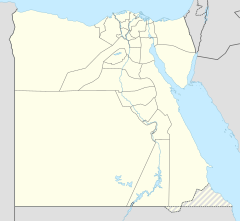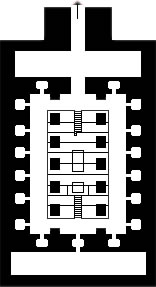Osireion
| Osireion | |
|---|---|
 | |
| Religion | |
| Affiliation | Ancient Egyptian |
| Location | |
| Location | Abydos |
| Country | Egypt |
 Shown within Egypt | |
| Geographic coordinates | 26°11′03″N 31°55′06″E / 26.1841°N 31.9184°ECoordinates: 26°11′03″N 31°55′06″E / 26.1841°N 31.9184°E |
| Materials | Stone |

The Osirion or Osireon is an ancient Egyptian temple. It is located at Abydos, to the rear of the Mortuary Temple of Seti I.
It is an integral part of Seti I's funeral complex and is built to resemble an 18th Dynasty Valley of the Kings tomb.[1] It was discovered by archaeologists Flinders Petrie and Margaret Murray, who were excavating the site in 1902–03. The Osirion was originally built at a considerably lower level than the foundations of the temple of Seti, who ruled from 1294 to 1279 BC.[2] While there is disagreement as to its true age, Peter Brand says it "can be dated confidently to Seti's reign".[3] Strabo, who visited the Osireion in the first century BC, said that it was constructed by Ismandes, or Mandes (Amenemhet III, 12th dynasty, who reigned in the 19th and 18th centuries BC), the same builder as the Labyrinth at Hawara:
Above this city [Ptolemaïs] lies Abydus, where is the Memnonium, a royal building, which is a remarkable structure built of solid stone, and of the same workmanship as that which I ascribed to the Labyrinth, though not multiplex; and also a fountain which lies at a great depth, so that one descends to it down vaulted galleries made of monoliths of surprising size and workmanship.[4]
See also[]
- List of megalithic sites
References[]
- ^ Bard, Katheryn (1999). Encyclopedia of the Archaeology of Ancient Egypt. Routledge. p. 114. ISBN 0-415-18589-0.
- ^ Rice, Michael (1999). Who's Who in Ancient Egypt. Routledge.
- ^ Brand, Peter J. The Monuments of Seti I: Epigraphic, Historical and Art Historical Analysis Brill September 2000, ISBN 978-90-04-11770-9 p. 175
- ^ Strabo. Geography, 17.1.42
External links[]
| Wikimedia Commons has media related to Osireion. |
- The Osirion The original notes by archeologist Sir William Flinders-Petrie on the discovery of the Osirion site, published in 1903.
Bibliography[]
- Frankfort, H., De Buck, A. & Gunn, B. The Cenotaph of Seti I at Abydos, 2 vol. Memoir of the Egypt Exploration Society, Egypt Exploration Society. London, 1933.
- Hornung, Erik, trans. from German by David Lorton. The Ancient Egyptian Books of the Afterlife. Cornell University Press, Ithaca, New York, 1999.
- Murray, Margaret A. The Osirion at Abydos, British School of Egyptian Archeology n°1, London, 1904.
- O'Connor, David. Abydos: Egypt's First Pharaohs and the Cult of Osiris, Thames & Hudson, London, 2009 and 2011.
- Petrie, Flinders. The Osirion at Abydos
- Pinch, Geraldine. Egyptian Mythology: A Guide to the Gods, Goddesses, and Traditions of Ancient Egypt. Oxford University Press, 2002.
- Naville, Edouard. "Abydos". The Journal of Egyptian Archaeology, vol. 1, no. 1, 1914, pp. 2–8. JSTOR, www.jstor.org/stable/3853664.
- Murray, Margaret Alice., J. G. Milne, and W. E. Crum. The Osireion at Abydos. London: Histories & Mysteries of Man, 1989. Print.
- Seti I
- Abydos, Egypt sites
- Ancient Egypt stubs

